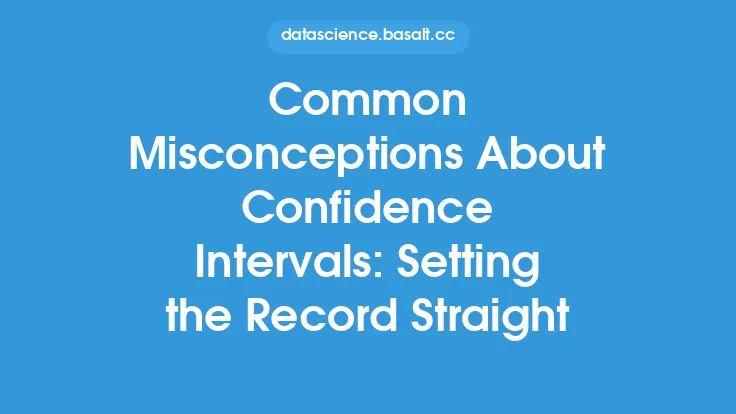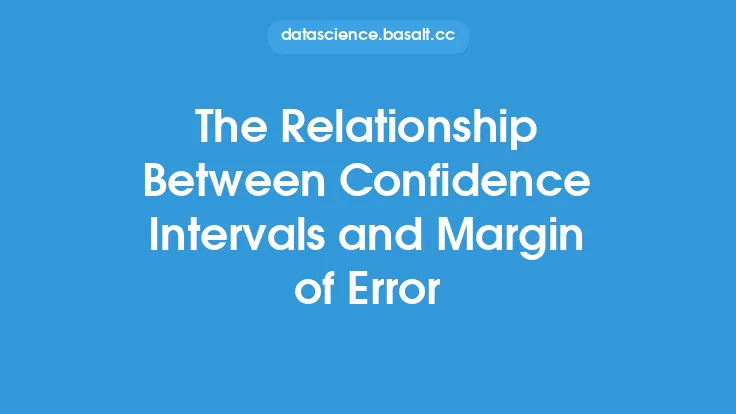When dealing with statistical analysis, confidence intervals are a crucial concept that helps in understanding the reliability of the estimates made from a sample of data. A confidence interval provides a range of values within which a population parameter is likely to lie. It gives an indication of the amount of uncertainty associated with a sample estimate. However, interpreting these intervals can be complex, and it's essential to understand what the numbers really mean.
Introduction to Confidence Interval Interpretation
Interpreting confidence intervals requires a good understanding of the underlying statistical concepts. A confidence interval is constructed from a sample of data and is used to estimate a population parameter. The interval is defined by a lower and upper bound, and it's associated with a confidence level, which is the probability that the interval contains the true population parameter. For example, a 95% confidence interval means that if the same sample were taken multiple times, and a confidence interval constructed each time, 95% of those intervals would contain the true population parameter.
Understanding Confidence Level and Interval Width
The confidence level and the width of the interval are closely related. A higher confidence level will result in a wider interval, while a lower confidence level will result in a narrower interval. This is because a higher confidence level requires a greater range of values to capture the true population parameter. The width of the interval is also affected by the sample size, with larger samples resulting in narrower intervals. This is because larger samples provide more information about the population, reducing the uncertainty associated with the estimate.
Margin of Error and Its Impact on Confidence Intervals
The margin of error is a critical component of a confidence interval. It's the amount of error allowed in the estimate, and it's related to the confidence level and the sample size. A smaller margin of error will result in a narrower interval, while a larger margin of error will result in a wider interval. The margin of error is calculated using the standard error of the estimate, which is a measure of the variability of the sample. The standard error is affected by the sample size, with larger samples having smaller standard errors.
One-Tailed and Two-Tailed Confidence Intervals
There are two types of confidence intervals: one-tailed and two-tailed. A one-tailed interval is used when the alternative hypothesis is one-sided, such as when testing for an increase or decrease in a population parameter. A two-tailed interval is used when the alternative hypothesis is two-sided, such as when testing for a difference in a population parameter. The choice of interval depends on the research question and the type of test being performed.
Confidence Intervals for Means and Proportions
Confidence intervals can be constructed for both means and proportions. When constructing an interval for a mean, the sample mean is used as the estimate, and the standard error of the mean is used to calculate the margin of error. When constructing an interval for a proportion, the sample proportion is used as the estimate, and the standard error of the proportion is used to calculate the margin of error. The formula for constructing an interval for a mean is different from the formula for constructing an interval for a proportion, reflecting the different types of data being analyzed.
Interpreting Overlapping Confidence Intervals
When comparing two or more groups, confidence intervals can be used to determine if there are significant differences between the groups. If the intervals overlap, it suggests that there may not be a significant difference between the groups. However, if the intervals do not overlap, it suggests that there may be a significant difference. The amount of overlap required to conclude that there is no significant difference depends on the confidence level and the sample size.
Common Mistakes in Interpreting Confidence Intervals
There are several common mistakes that can be made when interpreting confidence intervals. One of the most common mistakes is to assume that the confidence interval provides the probability that the true population parameter lies within the interval. However, this is not the case. The confidence interval provides the probability that the interval contains the true population parameter, not the probability that the true population parameter lies within the interval. Another common mistake is to assume that a wide interval indicates a large amount of uncertainty, while a narrow interval indicates a small amount of uncertainty. However, the width of the interval is affected by the sample size and the confidence level, and a wide interval may not necessarily indicate a large amount of uncertainty.
Best Practices for Interpreting Confidence Intervals
To interpret confidence intervals correctly, it's essential to follow best practices. First, it's essential to understand the research question and the type of test being performed. Second, it's essential to choose the correct confidence level and interval type. Third, it's essential to calculate the margin of error correctly and to use the correct formula for constructing the interval. Finally, it's essential to avoid common mistakes, such as assuming that the confidence interval provides the probability that the true population parameter lies within the interval.
Conclusion
In conclusion, interpreting confidence intervals requires a good understanding of the underlying statistical concepts. The confidence level, interval width, and margin of error are all critical components of a confidence interval, and they must be understood in order to interpret the interval correctly. By following best practices and avoiding common mistakes, researchers can use confidence intervals to provide reliable estimates of population parameters and to make informed decisions. Whether you're working in academia, industry, or government, understanding confidence intervals is essential for making sense of statistical data and for communicating results effectively.





